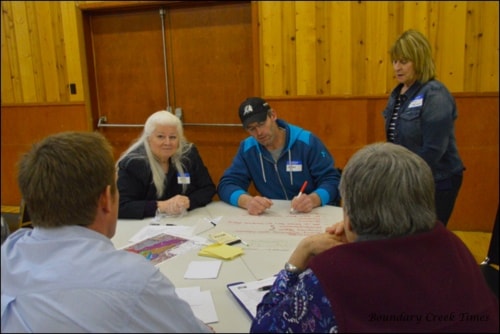“Tonight will be another step on the ladder,” said Area E Rural Director Bill Baird on March 11 as he welcomed more than 40 residents from across the Boundary to a public input session sponsored by the Kettle River Watershed Management Plan Stakeholder Advisory Group.
“Sustaining the Flow: managing water supply and demand to support ecosystem health and community needs” was the title of the event. Also on hand for the evening was Grace McGregor, rural director at Christina Lake and board chair of the Regional District of Kootenay Boundary (RDKB), members of the stakeholder advisory group and project coordinator Graham Watt.
The meeting, held in Midway, came on the heels of the recent release of the committee’s third discussion paper (Sustaining the Flow). This and earlier discussion papers covering the vision and goals for the watershed as well as another on decision-making and governance, are available online at www.kettleriver.ca.
“There are a lot of challenging issues to discuss,” said Watt. “How will our communities prepare for a multi-year drought? What is the role of water storage in providing for human use and keeping fish and other organisms alive in the river? How do we help agricultural producers in improving water conservation and irrigation efficiency? We’ll be looking for your ideas about how to do this right.”
McGregor added, “This is the part of the watershed plan that is most important—involving the communities that the plan is meant to support.”
The session was focused on water supply and water conservation: how water is used and stored; and what conservation measures could be implemented that would benefit the watershed.
Watt said it is expected that the final plan will have recommendations for all levels of government—provincial, regional and local.
Watt gave a brief introduction into the watershed plan and an overview of the issues that brought the work together. Adoption of water conservation is of great importance, he said—conserving water is between 10 to 25 per cent of the cost of funding new water supplies such as storage dams.
He said planning for low-flow and drought is a priority. “My view and the view of our advisory committee is that provincial regulatory response to low flow hasn’t worked very well,” he cautioned. “It hasn’t really protected individuals or communities and helped us get ahead of the game.”
The meeting was divided into four round table discussion groups, each focusing on a different facet of water supply and conservation: priority uses of water, innovations in water conservation, smart water storage, and planning for drought.
The information gathered at the meeting will be used to inform the watershed management plan, due to be released later in draft in late May or June.
Watt said there is already a commitment from the regional district for three years of implementation. “Core funding for coordination and a commitment to help locate the money for other projects the stakeholder advisory group would like to see happen. Then it is a work in progress from there, as we use it as a tool to leverage resources for things that we can’t do alone.”
Priorities for water allocation had ecosystem health and food production topping the list with domestic use coming in third followed by recreational users and acknowledgement of the historical industrial uses of water in the area.
Water use should not compromise water quality nor should water be diverted to other watersheds.
“None of this is going to happen unless we have a local authority making these decisions,” cautioned Kathy O’Malley, who acted as reporter for the water use round table. “We need to make sure we have the capacity to make decisions in all of these areas and that we are the ones making the decisions.”
Public education was seen as a key by the conservation, storage and drought management round tables.
There will be another public input meeting prior to the final draft of the plan being written, on April 15 from 11 a.m. to 3 p.m. in Grand Forks (location to be announced). The topic will be floodplain, wetland, and riparian area management. More information is available online at www.kettleriver.ca.
